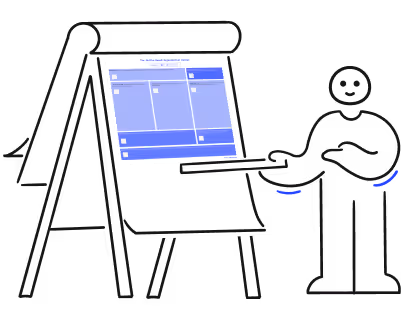7 steps to (easily) optimize your operational processes

Empower your organization with the skills-based canvas.

Your business is growing - congratulations!
However, with growth comes the need to delegate daily tasks to free up time. You have probably already heard that it’s also important to optimize your business operational processes, or systematize your business.
But what does that bring you, concretely?
Once a process is created and communicated, employees know what to do and how to do it. This eliminates the need for constant supervision and micromanagement and can save you valuable time.
Sounds interesting?
Business process definition
A business process, or operational process, is a series of activities or tasks needed to reach a particular goal. Business processes are usually broken down into smaller sub-processes, each of them with a specific purpose.
Let’s take a look at how you could optimize your business processes in 7 easy steps!
What is business optimization?
Optimization, systematization, automation…
How to know what’s what?
No worries, we’ll explain it all!
Process optimization is the improvement of an existing process to make it more efficient. The goal of process optimization is to save time, money and resources, without compromising on quality.
Systematization refers to the creation of systems and processes that aim to streamline and optimize business operations.
Automation means using technology to automate manual tasks or processes.
So what is the difference ?
Process optimization aims to improve an existing process. Systematization is about creating new systems and processes. Automation uses technology to automate manual tasks.
Automating tasks yields many benefits
Operational or business processes are the bread and butter of any business - they lead to the efficient production of goods and services, and therefore deliver results.
By automating your processes, you will save time, have better communication with your team and improve the quality of your work (and theirs).
Sounds good, doesn’t it?
Improved organization
When you optimize your processes you streamline them to make them more efficient. This can go from a new way of thinking about how tasks are assigned and executed to automating repetitive tasks.
In the end, reducing the number of steps in a process significantly reduces the risk of error during implementation.
Improved communication
If a process is set up but it is poorly explained or communicated, your team may not be aware of it. This can lead to confusion and frustration, on top of time and resource waste.
By documenting and communicating your processes, you make sure everyone is on the same page and knows what is expected of them.
Increased quality
Process organization can help produce better results while saving time and effort. Your employees will be more productive if they know what they need to be doing and how to do it.
Furthermore, automated tasks are often more accurate and consistent than manual tasks.
Which operations can be systemized?
There are a multitude of recurring and business-specific tasks that can be easily systematized.
So why not try it out?
Onboarding new employees
The arrival of a new employee involves a large amount of onboarding tasks that must be performed in order to help them integrate into their new position.
Often times, several people are involved in the onboarding process and steps can get forgotten or duplicated. In short, an event that should be positive can quickly become a source of frustration for your team.
By creating an onboarding process, you ensure that all the necessary measures are taken and that nothing is forgotten.
This will also create a less chaotic onboarding atmosphere for your new employees.
And after all, you want your employees to be happy!
Customer relationship management
From the first contact with a potential client to the after-sales service, managing customer relationships involves many steps.
By systemizing these tasks, you will be able to better identify your clients’ needs, offer a better experience and build strong relationships.
Project management
Process management can be broken down into several smaller sub-processes, each with its own specific purpose.
Systematizing this process is often the key to ensure that all projects are completed on time and on budget.
Internal communication
In any company, there are several channels of internal communication — ranging from email and using the intranet to in-person meetings.
By systematizing how these channels are used, information is properly disseminated and everyone is informed of all pertinent changes.
Common procedures
Standard Operating Procedures (SOPs) are a set of detailed instructions that describe the steps to follow to complete a given task.
Creating standard operating procedures for your business ensures that tasks are always performed in the same way, which leads to consistent quality.
What? Create a process for procedures?
As procedures must be followed each time a task is performed, they are an essential part of any process.
Which steps require the creation of a process or systematizing?
Some of the main stages in the evolution of a business require implementing a process, or systematizing. Creating and documenting processes is one of the pillars of any business that operates smoothly and efficiently.
New employee onboarding
As your business grows, you hire more and more employees.
It is crucial that you create an onboarding process for your new hires so that they can be operational and productive as quickly as possible.
Revamp your program with our free onboarding template! Get started for free and make your onboarding program stand out from the crowd!
Position multiplication
Multiplying positions is an important step, and it is essential that you establish a process for the onboarding of your new team members.
Being surrounded by performing employees is a privilege you must take advantage of!
By creating a methodology you will be able to pass on their knowledge and skills to other team members.
Integrating new software
When you integrate new software, there is usually a learning curve for your employees.
It’s very normal!
However, by documenting and recording procedures about the use of the new software,, everyone will know how to use it. This will lead to great time and energy savings (which we all like!).
Launching a new product or service
When launching a new product or service, there are a lot of moving parts that need to coordinate smoothly. It all can get complex very quickly.
Setting up a procedure to market new products and services allows you to not overlook anything and make sure everything goes as planned.
This way you also make sure there are no bad surprises!
Creating marketing campaigns
Creating, planning and executing marketing campaigns involves many steps. Establishing a process guarantees compliance in the planning and execution of your campaigns.
Marketing campaigns are often very costly. For them to be cost-effective, the results must be carefully monitored and analyzed.
Setting up a process for marketing campaigns allows you to track their effectiveness and make any necessary changes.
Outsourcing tasks
Anytime a company grows, its expansion leads to delegating certain tasks to external suppliers.
But this can be a scary step.
Setting up a process for this purpose allows you to choose the right suppliers according to your needs and ensures that tasks are carried out according to your specifications.
Delegating tasks internally
As your company grows, the tasks that need to be accomplished also multiply.
In itself, this is great news. But you will need to find a way to have more time.
In order to free up your time, you will have to delegate some of these tasks to other people. Having a process in place to do this ensures that tasks are well assigned and carried out according to your expectations.
This is also a great opportunity to develop a sense of initiative and intrapreneurship within your team.
How to systematize in 7 steps
Now that you know how important it is to systemize or create processes, let’s see how you can do it.
Setting up a process is not as difficult as it seems. In fact, one you start you’ll find it is quite easy.
However, there are a few elements you must keep in mind when setting up a process.
First of all, it is impossible to set up all the processes of your company by yourself. You will benefit from getting your employees involved in the creation of the content.
After all, they are in the best position to know how to get the job done!
You can start by selecting a few key processes which will have a significant impact when implemented.
1. Identify the current situation and the ultimate goal
What would you like to achieve through this process?
What is the end result ?
The first step in optimizing your business processes is assessing your current situation and your ultimate goal.
Think about the tasks that you and your team members are responsible for on a daily basis.
- Do some tasks take longer that they should?
- Are there ways to streamline the way these tasks are accomplished?
Once you have a good understanding of your current situation, you can start making changes, but not before!
2. Break down the steps
Once you have identified the goal, start by breaking down the steps you need to take in order to achieve it.
Be as accurate as possible.
For example, if you want to set up an onboarding process for new employees, the steps could include:
- organizing an orientation meeting;
- sending a welcome email;
- conducting an office tour;
- designating a counterpart;
- reviewing company policies and procedures;
- setting up the employee’s computer and email;
- reviewing the employee’s job description.
3. Estimate the time required by each step
This will allow you to estimate how long the process will take, from start to finish.
Why is this necessary?
This is important information when setting up a process because you will have to allocate time and resources to it. It will remove uncertainty in the operations management and make schedule planning easier.
4. Determine who will be responsible for each task
Once you have identified the steps in the process, determine who will be responsible for each task. This is especially important if you delegate tasks to others.
It is crucial that you entrust tasks to individuals or teams who have the skills and knowledge to accomplish them.
5. Document the process
The key is to verify that the steps are easy to follow, through the use of simple language and clear instructions.
One of the crucial steps (although they are all important) of setting up a process is to document it.
There are many ways to do it, such as creating a process diagram, as well as:
- creating an organizational chart;
- writing down the steps in a document;
- using a mapping software to create a process map.
Visual documentation, such as process mapping, allows everyone to understand it and know what is expected of them.
It also simplifies the process and makes it easy to modify it, if needed.
6. Test the process
Once you have set up and documented a process, it is time to test it. This is a fundamental step in identifying areas for improvement.
Testing the newly created process also helps to see if employees understand and follow the steps well.
There are several ways to test a process:
- running the process yourself;
- having your employees test it;
- organizing a discussion group.
After testing the process, you can make any necessary changes and improve it.
You then have to implement it and notice if it works as planned.
7. Systematize knowledge management
Once the process is created, it is important that you store it in a central location where it is easily accessible to everyone. This way, everyone uses the same version of the process and has access to the most up-to-date information.
A knowledge management system (KMS) is a great way to achieve it.
A KMS is a system that allows process management in addition to sharing information within an organization.
There are many types of KMS, and they all share the same goal: making information available to those who need it.
The most important aspect when choosing a KMS is making sure it is easy to use and it meets the needs of your organization.
There are many factors to consider when choosing such a system, including:
- the size of the organization;
- the type of information to be shared;
- the number of people who need to access the system;
- the budget allocated to the system.
Once you have analyzed these factors, you can start considering the different types of KMS and choose the one that best suits your needs.
Trust: a key component of successful process management
As previously mentioned, delegating is a key part of any process.
Tasks that are not delegated are often badly executed, if at all.
However, in order to delegate effectively, you need to trust the people you will be delegating to. When you trust your team, you are able to delegate more effectively and create processes that work.
But building trust doesn’t happen overnight, it takes time and effort. It is therefore important to choose the right people and give them the training and support they need to succeed.
Otherwise, it can be easy to start having a controlling attitude, which is not an effective way to manage employees. When you try to control tasks delegated to other people, you risk sabotaging the entire process.
We must admit that few things are more annoying than being micromanaged.
Trying to control everything only leads to frustration, on both sides.
So how do you build trust ?
- be clear about expectations;
- give employees the autonomy they need to do their job;
- encourage open communication.
A relationship of trust also requires:
- choosing the right people;
- giving them the training and support they need to succeed;
- monitoring their progress and providing feedback;
- being available to answer questions.
You can start by delegating small tasks and gradually increase responsibilities, as the person you have delegated to proves themselves.
It is also important that you provide feedback throughout the process, both positive and negative. This will help your employees understand your expectations.
By following these tips, you will create an environment of trust that is conducive to the success of any process.
How can Workleap LMS help you implement business processes?
Hiring additional staff is only part of the solution, when it comes to growing your business.
Another part of it has to do with creating efficient processes. By following these steps you could optimize your business processes and have your organization run like a well-oiled machine!
At Workleap LMS, we know that creating and monitoring processes can be complex. That’s why we offer a platform that allows you to create training courses and easily document your teams’ knowledge.
This is called a Learning Management System (LMS).
Through our platform, you can easily create and offer training material that will help your team members understand and correctly follow the steps of any process. Request your LMS demo today!
Discover, manage, and grow your team’s skills to unleash their potential and retain your rising stars.


%20(1).avif)


.avif)
.avif)








